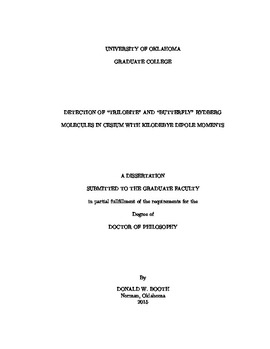| dc.contributor.advisor | Shaffer, James | |
| dc.contributor.author | Booth, Donald | |
| dc.date.accessioned | 2015-04-06T17:04:55Z | |
| dc.date.available | 2015-04-06T17:04:55Z | |
| dc.date.issued | 2015-04-06 | |
| dc.identifier.uri | https://hdl.handle.net/11244/14244 | |
| dc.description.abstract | The detection and characterization of two classes of ultralong-range Rydberg molecules known as "trilobite" and "butterfly" molecules is presented. These molecules are a subset of a class of Rydberg molecules which asymptotically consist of a Rydberg atom and a ground state atom. The trilobite and butterfly molecules have giant, body-fixed permanent dipole moments on the order of 1000 Debye. The two classes of molecules are distinguished by the relative dominance of the s-wave and p-wave electron scattering. Spectra for (nS_1/2 + 6S_1/2) ^3 Sigma molecules, where n = 37, 39 and 40 and measurements of the Stark broadenings of selected trilobite states in Cs due to the application of a constant external electric field are presented. Additionally, measurements of spectra and Stark splittings for p-wave dominated (nS_1/2 + 6S_1/2) ^3 Pi molecules, where n = 31 and 32 are presented. Computational work on Rydberg pair interactions is also discussed. | en_US |
| dc.language | en_US | en_US |
| dc.subject | Physics, Atomic. | en_US |
| dc.subject | Physics, Molecular. | en_US |
| dc.subject | Physics, Optics. | en_US |
| dc.title | DETECTION OF "TRILOBITE" AND "BUTTERFLY" RYDBERG MOLECULES IN CESIUM WITH KILODEBYE DIPOLE MOMENTS | en_US |
| dc.contributor.committeeMember | Shi, Zhisheng | |
| dc.contributor.committeeMember | Murphy, Sheena | |
| dc.contributor.committeeMember | Parker, Gregory | |
| dc.contributor.committeeMember | Abraham, Eric | |
| dc.date.manuscript | 2015-04-03 | |
| dc.thesis.degree | Ph.D. | en_US |
| ou.group | College of Arts and Sciences::Homer L. Dodge Department of Physics and Astronomy | en_US |
